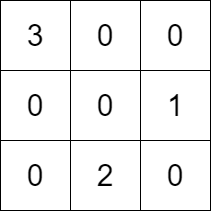LeetCode in Kotlin
2392. Build a Matrix With Conditions
Hard
You are given a positive integer k. You are also given:
- a 2D integer array
rowConditionsof sizenwhererowConditions[i] = [abovei, belowi], and - a 2D integer array
colConditionsof sizemwherecolConditions[i] = [lefti, righti].
The two arrays contain integers from 1 to k.
You have to build a k x k matrix that contains each of the numbers from 1 to k exactly once. The remaining cells should have the value 0.
The matrix should also satisfy the following conditions:
- The number
aboveishould appear in a row that is strictly above the row at which the numberbelowiappears for allifrom0ton - 1. - The number
leftishould appear in a column that is strictly left of the column at which the numberrightiappears for allifrom0tom - 1.
Return any matrix that satisfies the conditions. If no answer exists, return an empty matrix.
Example 1:

Input: k = 3, rowConditions = [[1,2],[3,2]], colConditions = [[2,1],[3,2]]
Output: [[3,0,0],[0,0,1],[0,2,0]]
Explanation: The diagram above shows a valid example of a matrix that satisfies all the conditions.
The row conditions are the following:
-
Number 1 is in row 1, and number 2 is in row 2, so 1 is above 2 in the matrix.
-
Number 3 is in row 0, and number 2 is in row 2, so 3 is above 2 in the matrix.
The column conditions are the following:
-
Number 2 is in column 1, and number 1 is in column 2, so 2 is left of 1 in the matrix.
-
Number 3 is in column 0, and number 2 is in column 1, so 3 is left of 2 in the matrix.
Note that there may be multiple correct answers.
Example 2:
Input: k = 3, rowConditions = [[1,2],[2,3],[3,1],[2,3]], colConditions = [[2,1]]
Output: []
Explanation: From the first two conditions, 3 has to be below 1 but the third conditions needs 3 to be above 1 to be satisfied.
No matrix can satisfy all the conditions, so we return the empty matrix.
Constraints:
2 <= k <= 4001 <= rowConditions.length, colConditions.length <= 104rowConditions[i].length == colConditions[i].length == 21 <= abovei, belowi, lefti, righti <= kabovei != belowilefti != righti
Solution
import java.util.LinkedList
import java.util.Queue
class Solution {
// Using topological sort to solve this problem
fun buildMatrix(k: Int, rowConditions: Array<IntArray>, colConditions: Array<IntArray>): Array<IntArray> {
// First, get the topo-sorted of row and col
val row = toposort(k, rowConditions)
val col = toposort(k, colConditions)
// base case: when the length of row or col is less than k, return empty.
// That is: there is a loop in established graph
if (row.size < k || col.size < k) {
return Array(0) { IntArray(0) }
}
val res = Array(k) { IntArray(k) }
val map: MutableMap<Int, Int> = HashMap()
for (i in 0 until k) {
// we record the number corresbonding to each column:
// [number, column index]
map[col[i]] = i
}
// col: 3 2 1
// row: 1 3 2
for (i in 0 until k) {
// For each row: we have number row.get(i). And we need to know
// which column we need to assign, which is from map.get(row.get(i))
// known by map.get()
res[i][map[row[i]]!!] = row[i]
}
return res
}
private fun toposort(k: Int, matrix: Array<IntArray>): List<Int> {
// need a int[] to record the indegree of each number [1, k]
val deg = IntArray(k + 1)
// need a list to record the order of each number, then return this list
val res: MutableList<Int> = ArrayList()
// need a 2-D list to be the graph, and fill the graph
val graph: MutableList<MutableList<Int>> = ArrayList()
for (i in 0 until k) {
graph.add(ArrayList())
}
// need a queue to do the BFS
val queue: Queue<Int> = LinkedList()
// First, we need to establish the graph, following the given matrix
for (a in matrix) {
val from = a[0]
val to = a[1]
graph[from - 1].add(to)
deg[to]++
}
// Second, after building a graph, we start the bfs,
// that is, traverse the node with 0 degree
for (i in 1..k) {
if (deg[i] == 0) {
queue.offer(i)
res.add(i)
}
}
// Third, start the topo sort
while (queue.isNotEmpty()) {
val node = queue.poll()
val list: List<Int> = graph[node - 1]
for (i in list) {
if (--deg[i] == 0) {
queue.offer(i)
res.add(i)
}
}
}
return res
}
}

